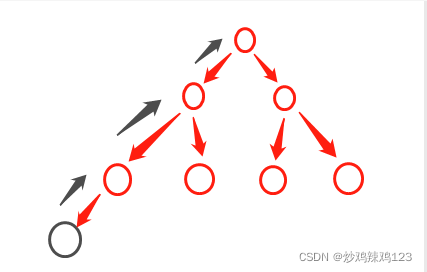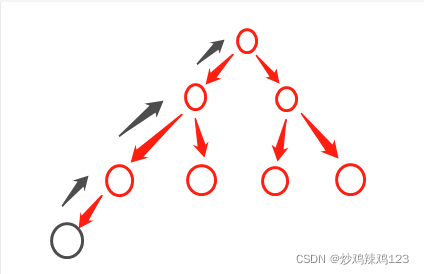这篇文章将为大家详细讲解有关Java如何实现二叉堆、大顶堆和小顶堆,小编觉得挺实用的,因此分享给大家做个参考,希望大家阅读完这篇文章后可以有所收获。什么是二叉堆二叉堆就是完全二叉树,或者是靠近完全二叉树结构的二叉树。在二叉树建树时采取前序建
这篇文章将为大家详细讲解有关Java如何实现二叉堆、大顶堆和小顶堆,小编觉得挺实用的,因此分享给大家做个参考,希望大家阅读完这篇文章后可以有所收获。
二叉堆就是完全二叉树,或者是靠近完全二叉树结构的二叉树。在二叉树建树时采取前序建树就是建立的完全二叉树。也就是二叉堆。所以二叉堆的建堆过程理论上讲和前序建树一样。
二叉堆本质上是一棵近完全的二叉树,那么大顶堆和小顶堆必然也是满足这个结构要求的。在此之上,大顶堆要求对于一个节点来说,它的左右节点都比它小;小顶堆要求对于一个节点来说,它的左右节点都比它大。
二叉堆建堆本质上和前序建堆差不多,只不过需要考虑的一点就是大小关系,这一点和二叉搜索树建树有点相似,所以可以得出结论,建树,本质上都是递归建树,只不过因为数据结构的大小要求不一样,需要的判断函数不一样,节点进入哪个位置也不一样。
大顶堆和小顶堆也分为稳定和不稳定的堆。稳定和不稳定指如果具备相同的值,那么他们的插入顺序应该和节点顺序一致。
首先,定义出基本的堆结构
public class BinaryHeap { private Integer value; private BinaryHeap leftChild; private BinaryHeap rightChild;}建堆过程与建二叉树过程一致
public static BinaryHeap buildHeap(BinaryHeap binaryHeap, Integer value) { if (Objects.isNull(binaryHeap)) binaryHeap = new BinaryHeap(); if (Objects.isNull(binaryHeap.getValue())) { binaryHeap.setValue(value); return binaryHeap; } if (Objects.isNull(binaryHeap.getLeftChild())) { BinaryHeap binaryHeap1 = new BinaryHeap(); binaryHeap1.setValue(value); binaryHeap.setLeftChild(binaryHeap1); } else if (Objects.nonNull(binaryHeap.getLeftChild())) { if (Objects.isNull(binaryHeap.getRightChild())) { BinaryHeap binaryHeap1 = new BinaryHeap(); binaryHeap1.setValue(value); binaryHeap.setRightChild(binaryHeap1); } else { // TODO: 2022/1/14 左右节点两种都不为null if (checkNull(binaryHeap.getLeftChild())) buildHeap(binaryHeap.getLeftChild(), value); else if (checkNull(binaryHeap.getRightChild())) buildHeap(binaryHeap.getRightChild(), value); else buildHeap(binaryHeap.getLeftChild(), value); } } return binaryHeap;}主要原理就是如果当前节点的左节点为空,则把当前值放到左节点,如果左节点不为空,右节点为空,则把值放到右节点。如果左右节点都不为空,就将建树过程转移到下一层,如果左节点有为空的子节点,就转移给左节点,如果左节点没有为空的子节点,且右节点有为空的子节点,那么转移给右节点。如果左右节点都没有为空的子节点,那么也转移给左节点。
以序列2,3,4,5,9,6,8,7为例,按照该算法建立出来的二叉堆结构如下:
{ "value": 2, "left_child": { "value": 3, "left_child": { "value": 4, "left_child": { "value": 8, "left_child": null, "right_child": null }, "right_child": { "value": 7, "left_child": null, "right_child": null } }, "right_child": { "value": 5, "left_child": null, "right_child": null } }, "right_child": { "value": 1, "left_child": { "value": 9, "left_child": null, "right_child": null }, "right_child": { "value": 6, "left_child": null, "right_child": null } }}大顶堆在建堆的基础上,有一个要求,根节点比左右子树的任何节点的值都大。那么建树的过程可以分为两步,对于每一个值,首先按照建树过程,会到二叉堆的最底部,然后通过不断的让自己与自己的根节点做比较,如果自己大于根节点,就交换自己与根节点的位置,递归回溯即可。

假设现在红色节点组成的已经是一个大顶堆,现在新增了一个节点到这个二叉堆中,而且是比任意节点都大,那么黑色箭头将是该节点的行动路线,它会反复与父级比较,如果大于父级,则交换和父级的关系。
public static BinaryHeap up(BinaryHeap father) { if (Objects.nonNull(father.getLeftChild())) { if (father.getValue() < father.getLeftChild().getValue()) { int c = father.getValue(); father.setValue(father.getLeftChild().getValue()); father.getLeftChild().setValue(c); } up(father.getLeftChild()); } if (Objects.nonNull(father.getRightChild())) { if (father.getValue() < father.getRightChild().getValue()) { int c = father.getValue(); father.setValue(father.getRightChild().getValue()); father.getRightChild().setValue(c); } up(father.getRightChild()); } return father;}该方法放在普通建树方法之后,就是大顶堆的建树方法了,总的方法如下:
public static BinaryHeap bigPush(BinaryHeap binaryHeap, Integer value) { binaryHeap = buildHeap(binaryHeap, value); up(binaryHeap); return binaryHeap;}还是以序列2,3,4,5,9,6,8,7为例,按照该算法建立出来的大顶堆结构如下:
{ "value": 9, "left_child": { "value": 8, "left_child": { "value": 7, "left_child": { "value": 2, "left_child": null, "right_child": null }, "right_child": { "value": 4, "left_child": null, "right_child": null } }, "right_child": { "value": 3, "left_child": null, "right_child": null } }, "right_child": { "value": 6, "left_child": { "value": 1, "left_child": null, "right_child": null }, "right_child": { "value": 5, "left_child": null, "right_child": null } }}小顶堆与大顶堆类似

过程与大顶堆一致,不过此时是比父级小就和父级交换。
public static BinaryHeap down(BinaryHeap father) { if (Objects.nonNull(father.getLeftChild())) { if (father.getValue() > father.getLeftChild().getValue()) { int c = father.getValue(); father.setValue(father.getLeftChild().getValue()); father.getLeftChild().setValue(c); } down(father.getLeftChild()); } if (Objects.nonNull(father.getRightChild())) { if (father.getValue() > father.getRightChild().getValue()) { int c = father.getValue(); father.setValue(father.getRightChild().getValue()); father.getRightChild().setValue(c); } down(father.getRightChild()); } return father;}这个是向下走的过程,最终代码为:
public static BinaryHeap smallPush(BinaryHeap binaryHeap, Integer value) { binaryHeap = buildHeap(binaryHeap, value); down(binaryHeap); return binaryHeap;}以序列2,3,4,5,9,6,8,7为例,按照该算法建立出来的小顶堆结构如下:
{ "value": 1, "left_child": { "value": 3, "left_child": { "value": 4, "left_child": { "value": 8, "left_child": null, "right_child": null }, "right_child": { "value": 7, "left_child": null, "right_child": null } }, "right_child": { "value": 5, "left_child": null, "right_child": null } }, "right_child": { "value": 2, "left_child": { "value": 9, "left_child": null, "right_child": null }, "right_child": { "value": 6, "left_child": null, "right_child": null } }}public static Integer bigPop(BinaryHeap binaryHeap) { Integer val = binaryHeap.getValue(); if (binaryHeap.getLeftChild().getValue() >= binaryHeap.getRightChild().getValue()) { binaryHeap.setValue(binaryHeap.getLeftChild().getValue()); BinaryHeap binaryHeap1 = mergeTree(binaryHeap.getLeftChild().getLeftChild(), binaryHeap.getLeftChild().getRightChild()); up(binaryHeap1); binaryHeap.setLeftChild(binaryHeap1); } else { binaryHeap.setValue(binaryHeap.getRightChild().getValue()); BinaryHeap binaryHeap1 = mergeTree(binaryHeap.getRightChild().getLeftChild(), binaryHeap.getRightChild().getRightChild()); up(binaryHeap1); binaryHeap.setRightChild(binaryHeap1); } return val;}public static Integer smallPop(BinaryHeap binaryHeap) { Integer val = binaryHeap.getValue(); if (binaryHeap.getLeftChild().getValue() <= binaryHeap.getRightChild().getValue()) { binaryHeap.setValue(binaryHeap.getLeftChild().getValue()); BinaryHeap binaryHeap1 = mergeTree(binaryHeap.getLeftChild().getLeftChild(), binaryHeap.getLeftChild().getRightChild()); down(binaryHeap1); binaryHeap.setLeftChild(binaryHeap1); } else { binaryHeap.setValue(binaryHeap.getRightChild().getValue()); BinaryHeap binaryHeap1 = mergeTree(binaryHeap.getRightChild().getLeftChild(), binaryHeap.getRightChild().getRightChild()); down(binaryHeap1); binaryHeap.setRightChild(binaryHeap1); } return val;}取出来之后,需要重新调用down或者up函数。以构建小顶堆,取出五次后的结果
public static void main(String[] args) { int[] a = new int[]{2, 3, 1, 4, 5, 9, 6, 8, 7}; BinaryHeap binaryHeap = new BinaryHeap(); for (int i = 0; i < a.length; i++) { binaryHeap = smallPush(binaryHeap, a[i]); } System.out.println(JSON.tojson(smallPop(binaryHeap))); System.out.println(Json.toJson(smallPop(binaryHeap))); System.out.println(Json.toJson(smallPop(binaryHeap))); System.out.println(Json.toJson(smallPop(binaryHeap))); System.out.println(Json.toJson(smallPop(binaryHeap))); System.out.println(Json.toJson(binaryHeap)); }取完后的小顶堆为:
{ "value": 6, "left_child": { "value": 7, "left_child": { "value": 8, "left_child": null, "right_child": null }, "right_child": null }, "right_child": { "value": 9, "left_child": null, "right_child": null }}关于“Java如何实现二叉堆、大顶堆和小顶堆”这篇文章就分享到这里了,希望以上内容可以对大家有一定的帮助,使各位可以学到更多知识,如果觉得文章不错,请把它分享出去让更多的人看到。
--结束END--
本文标题: Java如何实现二叉堆、大顶堆和小顶堆
本文链接: https://www.lsjlt.com/news/321514.html(转载时请注明来源链接)
有问题或投稿请发送至: 邮箱/279061341@qq.com QQ/279061341
下载Word文档到电脑,方便收藏和打印~
2024-05-05
2024-05-05
2024-05-05
2024-05-05
2024-05-05
2024-05-05
2024-05-05
2024-05-05
2024-05-05
2024-05-05
回答
回答
回答
回答
回答
回答
回答
回答
回答
回答
0